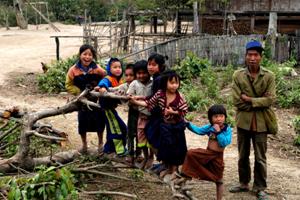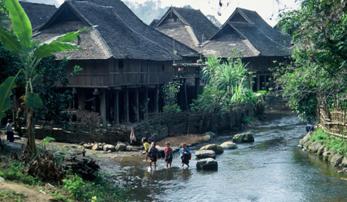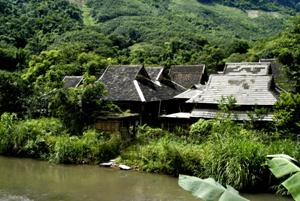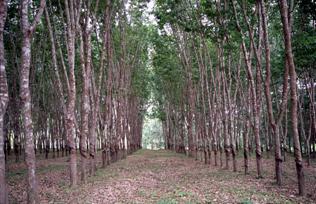
|
|
|
Short Communication
Advances in biogeography of the tropical rain forest in southern Yunnan, southwestern ChinaZhu Hua1 1 Xishuangbanna Tropical botanical Garden, the Chinese Academy of Sciences, Kunming, 650223. E-mail: [email protected]
Received: 16 January, 2008, Accepted: 18 February, 2008, Published: 3 March, 2008 Copyright: This is an open access paper. We use the Creative Commons Attribution 3.0 license - The license permits any user to download, print out, extract, archive, and distribute the article, so long as appropriate credit is given to the authors and source of the work. The license ensures that the published article will be as widely available as possible and that your article can be included in any scientific archive. Open Access authors retain the copyrights of their papers. Open access is a property of individual works, not necessarily journals or publishers Cite this paper as: Zhu Hua. 2008. Advances in biogeography of the tropical rain forest in southern Yunnan, southwestern China. Tropical Conservation Science 1(1):34-42. Available online: tropicalconservationscience.org. Introduction The tropical area of southern China located at the northern edge of tropical Asia, including southeastern Xizang (Tibet), southern Yunnan, southwestern Guangxi, southern Taiwan and Hainan Island between 86° and 123° E, 18°21' and 24°40' N with a disjunct site at c. 29° N in southeastern Xizang [1]. The largest tropical area still covered by forests is in southern Yunnan. 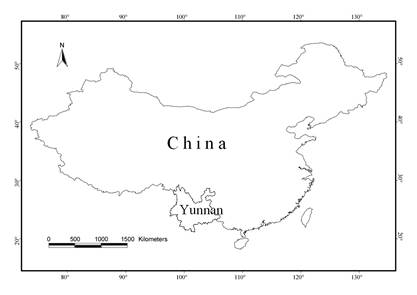 Fig 1. Province of Yunnan, China The tropical areas in southern Yunnan are those of valleys and lower montane generally below 900 m asl. between 21°01' and 24°40' N [2]. The main tropical rainforests of the world are in tropical lowlands with a mean annual temperature generally more than 24°deg;C and mean annual rainfall of more than 2,000 mm [3]. By comparison, the tropical area of southern Yunnan is at a higher latitude (500-900 m asl.) with relatively lower annual mean temperature (c. 22°deg;C) and lower annual mean precipitation (1,500 mm). The tropical forests in southern Yunnan were first mentioned by Wang in 1939 [4]. Between 1955 and 1960, these forests were surveyed by Sino-Russian expeditions and Yunnan University. It was then suggested that tropical rainforests existed in southern Yunnan, but these were considered to be a type different from the ones in Indo-Malaya [5] because of the lack of representatives of Dipterocarpaceae, which dominates the rainforests of tropical Asia. However, a dipterocarp forest was found in southernmost Yunnan in the 1970s, which indicated that the Indo-Malayan tropical rainforest existed in the region. It was later confirmed by Whitmore [6, 7], after a short visit to southern Yunnan, that there are true evergreen rainforests present in the southern fringes of China. Further biogeographical and ecological studies on the vegetation and flora of southern Yunnan revealed that the tropical rainforest in southern Yunnan, with physiognomic and floristic similarities to the Indo-Malayan rainforests, is a type of tropical Asian rainforest at the climatic limit of the northern edge of the tropical zone. It is identified as "tropical seasonal rainforest" [8-16]. Physiognomy and species diversity of the tropical rain forest in southern Yunnan The tropical seasonal rainforest in southern Yunnan, occurring on lower montane and valleys between 500-900 m asl., has a profile of three tree layers, of which the top layer is composed of emergent trees, and the second layer is the main canopy with the most density of individuals. This is the typical profile of equatorial lowland rainforests [17, 18]. In life forms, phanerophytes contribute 87.5-89.7% of the total species in the tropical seasonal rainforest. Of these, liana phanerophytes contribute 18.3-20.3%, megaphanerophytes 7.2-9.7%, mesophanerophytes 27-28%, microphanerophytes 12-15%, nanophanerophytes 8.3-9.7%, and herbaceous phanerophytes 4.2-4.6%. In leaf-scale spectra, mesophyllous leaves make up 71%, microphyllous leaves 20-23%, and macrophyllous leaves 5.5-7.5% of the total woody plants. In leaf types, compound leaves make up 21.4-24.5% of the total tree species [19]. In species diversity, 150-200 vascular plant species were recorded from a single sampling plot based on 10 sampling plots of 0.25 ha, of which 44-63 species were trees (if saplings and seedlings are included, it was 80-90 species), 30-40 species were lianas, 15-20 species were herbaceous plants, and 5-20 were epiphytes [20]. Shannon-Wiener's diversity indexes (base:2.718283) are 3.1594-3.599. A survey of 1 ha sampling plot yielded 150 tree species with DBH > 5 cm, and 119 species with DBH > 10 cm, respectively [15]. The long-tailed rank/abundance diagrams of the tropical seasonal rainforest indicate that the species with small population sizes make up an unusually large proportion of the total species composition [8, 16]. The frequency patterns also revealed that 40%-60% of tree species have only one individual, and 30%-40% of tree species two to five individuals. Fewer than 15% have 6-10 individuals and fewer than 10% have more than 10 individuals, from a 0.25 ha sampling plot [20]. 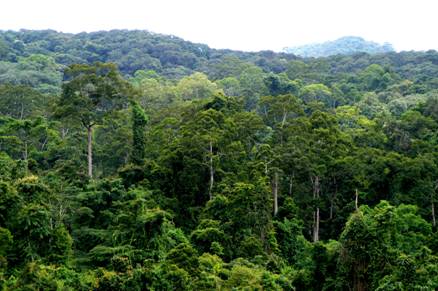 Fig 2. The tropical seasonal rain forest in southern Yunnan, China Floristic composition and geographical elements The families with most species richness in the tropical seasonal rainforest were ranked as Rubiaceae, Lauraceae, Annonaceae, Moraceae, Orchidaceae, Meliaceae, Vitaceae, Apocynaceae, Urticaceae, Rutaceae, Fagaceae, Acanthaceae, and Papilionaceae. Some families have only a small number of species, but they are the dominant families in phytosociological importance (dominant in individuals), such as Sapindaceae, Anacardiaceae, Burseraceae, Ebenaceae, Combretaceae, Ulmaceae, and Myrtaceae. The families Dipterocarpaceae, Barringtoniaceae, Tetrameleaceae, Myristicaceae, Guttiferae, Icacinaceae, Ixonanthaceae, and Sapotaceae have even fewer species, but have high phytosociological importance. At the generic level, Ficus has the highest species richness. Other genera with high species richness include Piper, Syzygium, Litsea, Lasianthus, Lithocarpus, Millettia, Pilea, Castanopsis, and Tetrastigma. Pometia, Terminalia, Antiaris, Girroniera, Pouteria, and Tetrameles have fewer species but high phytosociological importance in the dominant tree layer, as do Lasiococca, Garcinia, Mitrephora, Alphonsea, Cleidion, Sumbaviopsis, and Pittosporops is in the lower tree layer of the tropical seasonal rainforest. Based on the study of the distribution patterns of Chinese genera [21] and the studies on species distribution of the flora in southern Yunnan [10], 12 distribution types at generic level and 8 distribution types at specific level were recognized in the flora of the tropical seasonal rainforest. The genera of tropical distribution contribute 94% of the total genera; of these, the genera of tropical Asian distribution have the highest percentage among all distribution types, contributing 33-42%, while the genera of pantropical distribution contribute 20-25% of the total genera. The species of strictly tropical distribution contribute 76-80% of the total flora, and of these the species of tropical Asian distribution also show the highest percentage among all distribution types of species. These data indicate that the tropical seasonal rainforest has strong tropical Asiatic affinity floristically and is a type of tropical Asian rainforest. Comparison to tropical rain forests in equatorial Asia The tropical seasonal rainforest in southern Yunnan, which is similar to equatorial Asian lowland rainforests in profile, life-form spectra and leaf-scale spectra, was classified as a type of lowland rainforest, although it occurs at mountain habitats with higher altitude [2]. It differs from the latter only in having some deciduous trees in the canopy layer, more abundant woody lianas, fewer megaphanerophytes, and a relatively higher percentage of microphylls. It is a type of semi-evergreen rainforest at altitudinal and latitudinal limits. In species richness, the tropical seasonal rainforest of Yunnan has a relatively lower number of species per unit area than typical lowland rainforests in equatorial Asia. For example, in a 1 ha sampling area, 119 tree species with DBH > 10 cm were recorded from the tropical seasonal rainforest in southern Yunnan [15], while 214-223 tree species with DBH > 10 cm were recorded in Sarawak, Malaysia [22], 129-149 tree species in Kalimantan, Indonesia [23], and 145-184 tree species in Papua New Guinea [24]. In floristic composition, most of the dominant families from the tropical seasonal rainforest of southern Yunnan are dominant in the tropical rainforests in Malaysia. However, the tropical seasonal rainforest occurs on the margin of tropical Asia. Although tropical families and genera make up the majority of its total flora, the taxa of strictly tropical distribution are still under-represented in species richness compared to the Malaysian flora. For example, Dipterocarpaceae, Melastomaceae, Gutifferae, Myrtaceae, Myristicaceae, and Sapotaceae, which are dominant families in the tropical rainforests in Malaysia, have fewer species or less species richness in southern Yunnan. Geological history and factors resulting in formation of southern Yunnan rain forest During the Tertiary, southern Yunnan was covered by a subtropical evergreen broad-leaved forest characterized by Fagaceae species, and the climate was cooler and drier than the present day [25-27]. Current distribution patterns of the vegetation in southern Yunnan, shows deciduous forests dominated by tree species such as Anogeissus acuminata and Bombax ceiba on the banks and lower mountain slopes of the Mekong valley. The forest dominated by the palm species Livistona saribus, which usually occurs in drier habitats, is patchily distributed on lower mountains. The usual savanna species, such as Woodfordia fruticosa, Phyllanthus emblica, Cipadessa cinerascens, Lannea coromandelica, Bauhinia variegata, Grewia eriocarpa, Dalbergia obtusifolia, Helicteres angustifolia, Helicteris isora, Lagerstroemia tomentosa, Albizzia, Eriolaena, and Acacia, and the species that prefer dry habitats, such as Pistacia weinmanifolia, Cycas, and Dracaena, are frequently found in the tropical forests in southern Yunnan. These data indicate that the region did experience drier climate in the historical past [28]. The fundamental topography and climate of southern Yunnan have been strongly affected by the uplift of the Himalayas and the formation of the monsoon climate of East Asia [29]. It has been suggested that the moist tropical climate in southern Yunnan did not form until the Himalaya lifted to a certain elevation after the late Tertiary, allowing the development of the tropical rainforest in the region [2]. The Hengduan Mountains, which are situated north of southern Yunnan, form a barrier keeping out the cold air in winter, resulting, in southern Yunnan, in dense fog during the whole dry season to supplement the insufficient precipitation and in keeping the ground warm by reducing radiation cooling or long-wave effective radiation, conditions that seemed to have allowed for the presence of the tropical rain forest. A direct land connection between mainland SE Asia and Western Malesia existed until the early Pliocene (5 million years ago) and there was no geographical barrier to natural distribution of plants between mainland Southeast Asia and Western Malesia during most of the Tertiary [30]. The geological history of Southeast Asia could explain the Malaysian floristic affinity of the tropical seasonal rainforest in southern Yunnan.
Fig 3. Left: people of the village of Yao. Right: Village and people of Dai. Southern Yunnan, China. Discussion and implications for conservation The tropical seasonal rainforest in southern Yunnan has almost the same forest profile and physiognomic characteristics as equatorial lowland rainforests. It is undoubtedly a type of truly tropical rainforest. As the tropical seasonal rainforest occurs at the northern edge of the tropical zone and at the extreme limit of rainfall and temperature usually required by tropical rainforest, it differs from lowland rainforests in equatorial areas in having deciduous trees in the canopy layer, fewer megaphanerophytes and epiphytes, but more abundant lianas as well as more plants with microphylls. Abundant lianas could be a characteristic of rainforest in a monsoon climate. Fewer megaphanerophytes and a relatively higher percentage of microphylls may be a result of the fact that this occurs at climatic limits at the northern edge of the tropical zone and is influenced by seasonal dryness and the relatively low temperature. The flora of the tropical seasonal rainforest consists mainly of tropical floristic elements, which contribute more than 90 % at the generic level and more than 80% at the specific level to its total flora. The most dominant floristic elements at both the generic and specific levels are the ones of tropical Asian distribution. Most of the dominant families from the tropical seasonal rainforest are also dominant in the Indo-Malayan rain forests. This reveals that the flora of the rainforest of Yunnan is of tropical nature with a strong tropical Asian affinity. The tropical seasonal rainforest of southern Yunnan, in terms of physiognomy, is similar to the evergreen seasonal forest of the tropical America of Beard [31], or the moist evergreen type of African tropical rainforest of Hall and Swaine [32], or the Mesophyll vine forest of the Australian rainforest of Webb [33], as well as the semi-evergreen rainforest of Walter [34]. However, it is most equivalent to Whitmore's [7] semi-evergreen rainforests of Southeast Asia. The tropical seasonal rainforest in southern Yunnan nonetheless belongs to the tropical rainforest formation of Southeast Asia and is a type of semi-evergreen rainforest. Tropical rainforests occur at c. 27°31' N in northeastern India [35] and Burma [36]. The tropical rainforest in southern Yunnan, although it is not the northernmost type of tropical rainforest, occurs really at the climatic limits of tropical rainforest due to its high altitude. The occurrence of the tropical rainforest in southern Yunnan was more influenced by local habitats and microclimates than by regional climate.
Fig 4. Left: Village of Dai with rubber plantation behind. Right: Rubber plantation. Southern Yunnan, China. The tropical seasonal rainforest in southern Yunnan conspicuously decreased from a cover of 10.9% of the total area of the region in 1976 down to 3.6% in 2003, mainly due to rubber planting [37]. The high price of rubber has continued to promote the expansion of rubber plantations in the region (Fig. 3, 4). Rubber plantations, by replacing this unique type of tropical rainforest, are resulting in a loss of biodiversity. In the last 2,000 years, southern Yunnan reportedly has experienced six periods of climate change marked by alternating warm-wet and cool-dry conditions and 11 drought events and cold events, as well as 12 periods of fire damage [38]. Rubber is a strictly tropical species and the climatic conditions in southern Yunnan may not be suitable for its growth in the long-term, given the geological history of the area. Limiting further expansion of rubber plantations is the only way to conserve the tropical seasonal rainforest in southern Yunnan. Acknowledgements This project was funded by The National Natural Science Foundation of China (30570128, 30770158). I thank three anonymous reviewers very much for their important and constructive comments. I am very grateful to Tropical Conservation Science for assistance in improving the English and for other technical improvements in preparing this article. References [1] Cao, M., Zhou, X. M., Warren, M., and Zhu, H. 2006. Tropical forests of Xishuangbanna, China. Biotropica 38(3): 306-309. [2] Zhu, H. 1997. Ecological and biogeographical studies on the tropical rain forest of south Yunnan, SW China with a special reference to its relation with rain forests of tropical Asia. Journal of Biogeography 24: 647-662. [3] Richards, P. W. 1996. The tropical rain forest, an ecological study. Second edition. London: Cambridge University Press. [4] Wang, C. W. 1939. A preliminary study of the vegetation of Yunnan. Bulletin of the Fan Memorial Institute of Biology 9 (2): 65-125. [5] Fedorov, An. A. 1958. The tropical rain forest of China (in Russia with English summary). Botanicheskii Zhurnal S.S.S.R. 43: 1385-1480. [6] Whitmore, T. C. 1982. Fleeting impressions of some Chinese rain forests. Commonwealth Forestry Review 61: 51-58. [7] Whitmore, T. C. 1984. Tropical rain forest of the far east. Second Edition, Oxford: Clarendon Press. [8] Zhu, H. 2004. A tropical seasonal rain forest at its altitudinal and latitudinal limits in southern Yunnan, SW China. Gardens' Bulletin Singapore 56: 55-72. [9] Zhu, H. 2006. Forest vegetation of Xishuangbanna, south China. Forestry Studies in China 8(2): 1-58. [10] Zhu, H., Wang, H., Li, B. G., and Sirirugsa, P. 2003. Biogeography and floristic affinity of the Limestone flora in southern Yunnan, China. Annals of the Missouri Botanical Garden 90: 444-465. [11] Zhu, H. and Roos, M. C. 2004. The tropical flora of S China and its affinity to Indo-Malesian flora. Telopea 10(2): 639-648. [12] Zhu, H., Shi J. P., and Zhao, C. J. 2005. Species composition, physiognomy and plant diversity of the tropical montane evergreen broad-leaved forest in southern Yunnan. Biodiversity and Conservation 14: 2855-2870. [13] Zhu, H., Cao, M., and Hu, H. B. 2006b. Geological history, flora, and vegetation of Xishuangbanna, southern Yunnan, China. Biotropica 38(3): 310-317. [14] Zhu, H., Wang, H. and Li, B.G. 2006a. Floristic composition and biogeography of tropical montane rain forest in southern Yunnan of China. Gardens' Bulletin Singapore 58: 81-132. [15] Cao, M., Zhang, J. H., Feng, Z. L., Deng, J. W., and Deng, X. B. 1996. Tree species composition of a seasonal rain forest in Xishuangbanna, Southwest China. Tropical Ecology 37(2):183-192. [16] Cao, M., Zhang, J. H. 1997. Tree species diversity of tropical forest vegetation in Xishuangbanna, SW China. Biodiversity and Conservation 6:995-1006. [17] Robbins, R. G. 1968. The biogeography of tropical rain forest in SE Asia. In: Misra, R. and Gopal, B. (eds.) Proceedings of the Symposium in Recent Advances in Tropical Ecology. Varanasi: International Society for Tropical Ecology, Banaras Hindu University: 531-535. [18] Richards, P. W. 1983. The three-dimensional structure of tropical rain forest. In: Sutto, S. L. Ed. Tropical rain forest: ecology and management. Oxford: Blackwell Sci. Pub.: 3-10. [19] Zhu, H., Wang, H., and Li, B. G. 1998. Research on the tropical seasonal rainforest of Xishuangbanna, south Yunnan. Guihaia 18 (4): 37-384. (in Chinese with English abstract) [20] Zhu, H., Li, B. G., Wang, H., and Xu, Z. F. 1998. Species diversity of primary tropical rain forest of south Yunnan of China with special reference to sampling area. Chinese Biodiversity 6 (4): 241-247. (in Chinese with English abstract) [21] Wu, Z. Y. 1991. The areal-types of Chinese genera of seed plants. Acta Botanica Yunnanica Supp. 4: 1-139. (in Chinese with English abstract) [22] Proctor, J., Anderson, J. M., Chai, P., and Vallack, H. W. 1983. Ecological studies in four contrasting rain forests in Gununm Mulu National Park, Sarawak. I. Forest environment, structure and floristics. Journal of Ecology 71: 237-360. [23] Kartawinata, K., Abdulhadi, R., and Partomihardjo, T. 1981. Composition and structure of a lowland dipterocarp forest at Wanariset, East Kalimantan. �Malayan Forester 44: 397-406. [24] Paijmans, K. 1970. An analysis of four tropical rain forest sites in New Guinea. Journal of Ecology 58 (1): 77-101. [25] Liu, J. L., Tan, L. Y., Qiao, Y., Head, M. J., and Walker, D. 1986. Late Quaternary vegetation history at Menghai, Yunnan province, southwest China. Journal of Biogeography 13: 399-418. [26] Penny, D. 2001. A 40,000 year palynological record from north-east Thailand; implications for biogeography and palaeo-environmental reconstruction. Palaeogeography, Palaeoclimatology, Palaeoecology 171: 97-128. [27] Mehrotra, R. C., Liu, X. Q., Li, C. S., Wang, Y. F., and Chauhan, M.S. 2005. Comparison of the Tertiary flora of southwest China and northeast India and its significance in the antiquity of the modern Himalayan flora. Review of Palaeobotany and Palynology 135: 146-163. [28] Zhu, H. and Cai, L. 2005. Biogeography of the tropical rain forest of Yunnan and some implications to geographical history. Advance in Earth Sciences 20 suppl.: 1-57. (in Chinese with English abstract). [29] Shi, Y. F., Li, J, Y., Li, B. Y., Yao, T. D., Wang, S. M., Li, S. J., Tsui, Z. J., Wang, F. B., Pan, B. T., Fang, X. M., and Zhang, Q. S. 1999. Uplift of the Qinghai-Xizang (Tibetan) plateau and east Asia environmental change during late Cenozoic. Acta Geographica Sinica 54 (1): 10-21. (in Chinese with English abstract) [30] Morley, J. R. 1998� Palynological evidence for Tertiary plant dispersals in the SE Asian region in relation to plate tectonics and climate. In: Hall, R. and Holloway, J. D. ed. Biogeography and Geological Evolution of SE Asia. Leiden: Backbuys Publishers: 221-234. [31] Beard, J. S. 1955. The classification of tropical American vegetation types. Ecology 36: 359-412. [32] Hall, J. B., Swaine, M. D. 1976. Classification and ecology of closed-canopy forest in Ghana. �Journal of Ecology 64: 913-953. [33] Webb,L. J. 1959. A physiognomic classification of Australian rain forests. Journal of Ecology 47: 551-570. [34] Walter, H. 1971. Ecology of tropical and subtropical vegetation. Edinburgh: Oliver & Boyd.: 207-236. [35] Proctor, J., Haridasan, K., and Smith, G. W. 1998. How far north does lowland evergreen tropical rain forest go? Global Ecology and Biogeography Letters 7: 141-146. [36] Kingdon-Ward, F. 1945. A sketch of the botany and geography of north Burma. Journal of Bombay Natural History Society 45: 16-30. [37] Li, H. M., Aide, T. M., Ma, Y. X., Liu, W.J., and Cao, M. 2007. Demand for rubber is causing the loss of high diversity rain forest in SW China. Biodiversity and Conservation 16: 1731-1745. [38] Gu, Y. H., Deborah, M. P., Xie, S. C., and Yu, J. X. 2007. Vegetation and fire history of a Chinese site in southern tropical Xishuangbanna derived from phytolith and charcoal records from Holocene sediments. Journal of Biogeography Online early Articles. Comments Reader comments are generally moderated. If you find something inappropriate, please contact Tropical Conservation Science. The opinions expressed in reader comments are those of the author only, and do not necessarily reflect the opinions of other authors or Tropical Conservation Science. |
 |
Tropical Conservation Science is an open-access e-journal that publishes research relating to conservation of tropical forests and other tropical ecosystems.
Volume 1: Issue 1 Table of Contents Articles PDF version General interest review All issues Mar 2008 Jun 2008 Sep 2008 Dec 2008 Mar 2009 Jun 2009 Sep 2009 Dec 2009 Mar 2010 Jun 2010 Sep 2010 Dec 2010 Mar 2011 Jun 2011 Sep 2011 Dec 2011 Mar 2012 Jun 2012 Sep 2012 Dec 2012 Mar 2013 Jun 2013 Aug 2013 Sep 2013 Nov 2013 Dec 2013 Mar 2014 Jun 2014 Sep 2014 Dec 2014 Mar 2015 Jun 2015 Sep 2015 Dec 2015 Mar 2016 Jun 2016 Most downloaded 2008 2009 2010 2011 2012 All time ADVERTISEMENT SEARCH  This work is licensed under a Creative Commons Attribution-NonCommercial-NoDerivatives 4.0 International License. |
|
About | Privacy Copyright mongabay.com 2008-2014 |
